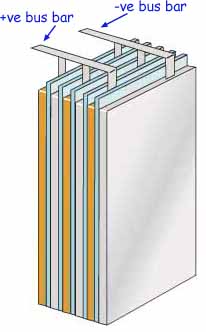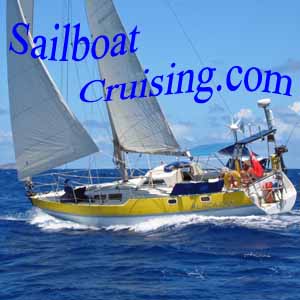- Home
- Electrical Systems
- Sailboat Wind Generator
- Deep Cycle Marine Battery
Why Choose a
Deep Cycle Marine Battery?
For everything other than engine starting, a deep cycle marine battery is the best marine battery type for your boat. But why is that?
Engine starter batteries need to provide a lot of 'oomph' for a very short time. Once the starter motor has done its job and the engine fires up, the alternator very quickly replaces the flood of amps drawn from the battery.
But if the engine doesn't start, and desperation with the starter button sets in, then the battery will very quickly be drained of its precious amps.
A deep cycle marine battery operates rather differently. Instead of providing a great surge of power over a short space of time, these types eke out their power more conservatively over a longer period of time and are thus the way to go for providing the sustained loads of our 12v domestic systems.
Which type it is - deep cycle marine battery or starting battery - depends on the way it's been constructed...
Battery Construction
Batteries operate on the principle that a voltage develops across two electrodes of dissimilar metals when they are immersed in an electrolyte. A 12 volt battery is made up of six individual cells connected in series within an outer plastic casing, the voltage generated in each cell being 2.1 volts.
Each cell is flooded with a sulphuric acid electrolyte and contains a number of electrically positive and negative plates - the dissimilar metals - the +ve plate being lead dioxide and the -ve, lead.
And it's the disposition of these vertical plates that distinguish a deep cycle marine battery cell from an engine starting battery cell...
An Engine Starter Battery Cell
 Internals of an engine starter battery
Internals of an engine starter batteryThis type of battery has a relatively large number of thin plates presenting a maximum surface area to the electrolyte, which enables them to release a high current to our boat engine's starter motor.
If a battery of this type is repeatedly discharged to about 50% of its capacity (12.2V) - say by the sustained loads of our boat's domestic system - then it will very soon die and refuse any kind of resuscitation.
Which is why we need a deep cycle marine battery (or several of them linked in parallel) to cater for the demands of the domestic system.
A Deep Cycle Marine Battery Cell
 Internals of a deep-cycle marine battery
Internals of a deep-cycle marine batteryInstead of the multiple thin plates of the starter battery, those of the deep cycle marine battery are thicker and there are fewer of them.
They're altogether more robust, and won't buckle and fail anything like so readily.
Now there's much less surface area to react with the electrolyte, so current release will be slower - ideal for the steady draw of our boats' domestic system.
The downside is that they're incapable of providing the quick surge of power required to spin over a high compression diesel engine effectively.
Artwork by Andrew Simpson
Leisure Batteries
So-called 'leisure' batteries (sometimes called 'dual purpose' batteries) are a compromise between starter and deep cycle marine batteries.
As a result they're a firm favourite of owners of small boats with space for just a single battery, or where electrical demands are modest.
Liquid Lead Acid Batteries
The three varieties of marine batteries described above are known as Flooded Cell or Liquid Lead-Acid Batteries. Not being sealed, flooded cell batteries lose water from the electrolyte due to evaporation and will need the occasional top-up.
You must always use distilled or de-ionized water for this. Don't be tempted to use tap water as it contains minerals and other impurities which may pollute and damage the cells.
The gas given off is a mixture of oxygen and hydrogen - mainly the latter - so there's always a theoretical risk of explosion if a naked flame or spark occurs. But both gases being lighter than air, a vented battery box will see them rapidly and harmlessly assimilated into the atmosphere.
One more thing - if the electrolyte (sulphuric acid) comes into contact with seawater, chlorine gas is produced, which is most definitely not what you want.
But there are other types...
Valve-Regulated Lead Acid (VRLA) Batteries
Standard flooded cell liquid lead-acid batteries have their electrolyte sloshing around in a vented container. Unless kept close to upright these types can leak - which is less than ideal if your boat if your boat is leaping around a bit, or worse, gets knocked down.
On the downside, rather more care is needed than when charging a deep cycle marine battery.
But the two types of VRLA batteries described here won't leak, even if inverted or the outer casing is broken...
Gel Batteries
Unlike a normal lead acid battery, gel marine batteries use a thixotropic gel to immobilize the electrolyte. These VRLA batteries have some significant benefits over flooded batteries...
- They're sealed, maintenance free and the fully absorbed electrolyte won't leak if the casing is damaged;
- Under normal operating conditions there's virtually no gassing. Unlike flooded cells, gel marine batteries are hermetically sealed and operate under pressure to recombine the oxygen and hydrogen produced during the charge process back into water. If the pressure mounts to high, a valve releases the gases to the atmosphere;
- A gel marine battery can be installed anywhere and in any orientation. On their side in the bilges is fine - they will even operate safely underwater;
- While flooded cells lose up to 1% per day due to self-discharge, VRLAs lose no more than 3% per month;
- Gel marine batteries are probably the most sensitive to overcharge abuse, with a maximum voltage of 14.4V being recommended. It's important to match the charge regime to the battery type;
- But a gel marine battery can cost up to 50% more than equivalent liquid lead acid batteries
AGM Batteries
AGM (Absorbed Glass Mat) Marine Batteries can do everything a Gel marine battery can, only more so. Particularly they can churn out plenty of cold cranking amps making them suitable for engine starting too.
Strictly speaking, AGM batteries are of the liquid lead acid type but, as their name suggests, the electrolyte is held by capillary action in a fine fibrous glass mat so doesn't slosh about. As with the gel cell type, they can be mounted anyway up and won't leak if the casing is breached.
Thanks to their low internal resistance, AGM batteries will accept high charging currents - meaning they can be charged very rapidly, though it's recommended that voltages be capped at 14.4V.
This characteristic makes them ideal for use with solar panels and windchargers and also allows them to release power quickly, making them suitable for engine starting.
All AGMs are comparatively expensive batteries but, if treated properly, they offer many advantages and have a long service life. Because of this, they could even be more economical in the long run.
Lithium Batteries
Lithium batteries are often hailed as the best option for marine use due to their numerous advantages. One of the most significant benefits is their lightweight nature; they are about half the weight of lead-acid batteries, making them a great choice for those looking to reduce the weight on their boat. Lithium batteries also have an impressive lifespan, lasting up to 10-12 years, which means you won't have to replace them as frequently.
Furthermore, lithium batteries provide consistent power throughout their life, ensuring that your boat operates smoothly. They are virtually maintenance-free, which is a huge plus for busy boaters. However, the initial cost of lithium batteries is higher than other types, which might be a consideration for those on a budget. Additionally, they may not be as widely available as other battery types, making them a bit harder to find.
Lead Carbon Batteries
Lead carbon batteries are a newer addition to the marine battery market and offer some unique advantages. One of the key benefits is that they produce less sulfation compared to traditional lead-acid batteries, which helps extend their lifespan. Additionally, lead carbon batteries require a lower charge voltage, making them more efficient to charge. These batteries also have a higher life cycle, meaning they can endure more charge and discharge cycles before needing replacement.
However, lead carbon batteries are not without their downsides. They are generally more expensive than traditional lead-acid batteries, which might be a deterrent for some buyers. Additionally, they are larger and heavier than other options, which could impact the overall weight and balance of your boat. It's also worth noting that lead carbon batteries cannot be used as starter motors, limiting their versatility.
Summary
In conclusion, each type of 12V marine battery has its own set of advantages and disadvantages. Wet lead acid batteries are cost-effective but require more maintenance, while sealed lead acid batteries offer better durability but at a higher cost. Lead carbon batteries provide longer lifespans but are heavier, and lithium batteries are lightweight and long-lasting but come with a higher initial price. Understanding these pros and cons can help you make the best choice for your boating needs.
Recent Articles
-
Is Marine SSB Still Used?
Apr 15, 25 02:05 PM
You'll find the answer to this and other marine SSB-related questions right here... -
Is An SSB Marine Radio Installation Worth Having on Your Sailboat?
Apr 14, 25 02:31 PM
SSB marine radio is expensive to buy and install, but remains the bluewater sailors' favourite means of long-range communication, and here's why -
Correct VHF Radio Procedure: Your Questions Answered
Apr 14, 25 08:37 AM
Got a question about correct VHF radio procedure? Odds are you'll find your answer here...

















